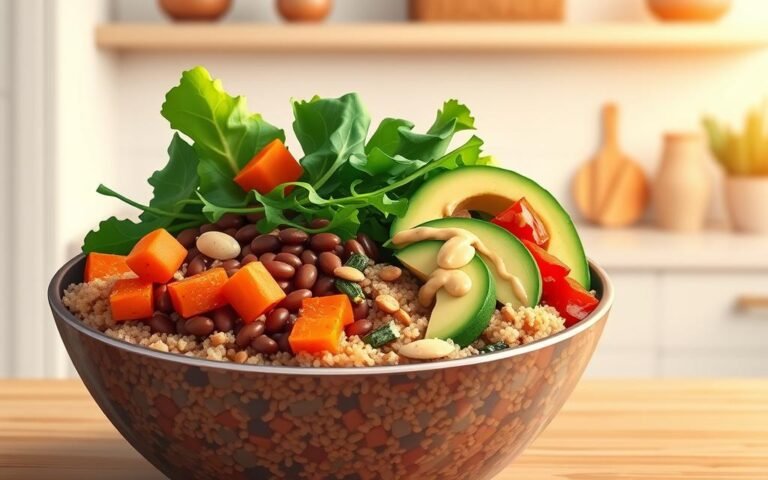For individuals leading active lifestyles, finding the right snack to fuel their bodies is crucial. A high-energy snack that’s both nutritious and delicious is hard to come by, but a homemade protein bar made with lentils could be the answer.
Made with wholesome ingredients, a homemade lentil protein bar is an excellent way to boost your energy levels. Lentils are a rich source of protein and fiber, making them an ideal ingredient for a healthy snack.
By making your own lentil protein bar at home, you can control the ingredients and ensure that you’re getting a snack that’s tailored to your dietary needs.
Key Takeaways
- Homemade lentil protein bars are a nutritious high-energy snack.
- Lentils are a rich source of protein and fiber.
- Making your own protein bars at home allows you to control the ingredients.
- A homemade lentil protein bar is perfect for active lifestyles.
- Using wholesome ingredients ensures a healthy snack.
The Rising Popularity of Plant-Based Protein Snacks
The world of protein snacks is undergoing a significant transformation, driven by the rising popularity of plant-based options. This shift is largely due to growing consumer awareness about health, sustainability, and the environmental impact of food choices.
Why Lentils Are Becoming a Protein Powerhouse
Lentils are emerging as a key ingredient in plant-based protein snacks due to their high protein content, rich nutrient profile, and versatility in recipes. They offer a sustainable alternative to traditional protein sources, aligning with the growing demand for eco-friendly food products.
- High protein content
- Rich in essential nutrients
- Environmentally friendly
The Shift Toward Homemade Energy Solutions
Consumers are increasingly turning to homemade energy solutions, driven by the desire for control over ingredients, customization of nutritional content, and the avoidance of preservatives found in commercial products. Making protein snacks at home, such as lentil protein bars, allows individuals to tailor recipes to their dietary needs and preferences.
Benefits of homemade energy solutions include:
- Control over ingredients
- Customization of nutritional content
- Avoidance of preservatives
Australian Health Trends and Protein Consumption
Australia is witnessing a significant trend towards health and wellness, with a particular focus on protein consumption. Australians are seeking high-quality protein sources, including plant-based options like lentils, to support their active lifestyles and dietary preferences. This trend is driving the demand for innovative protein snack recipes, including those featuring lentil protein.
Understanding the Nutritional Profile of Lentil Protein Bars
Lentil protein bars have emerged as a nutritional powerhouse, offering a compelling alternative to traditional energy bars. These bars are not just a convenient snack; they’re a nutrient-dense food product that can significantly contribute to one’s daily nutritional intake.
Protein Content Comparison: Lentils vs. Traditional Sources
When it comes to protein content, lentils stand out among traditional sources. A comparison of protein content per serving reveals that lentils offer a competitive edge. For instance, a 100-gram serving of cooked lentils contains approximately 9 grams of protein, whereas the same serving size of cooked chicken breast contains about 31 grams. However, lentil protein bars can be formulated to match or even exceed the protein content of traditional bars made with whey or soy protein.
Essential Amino Acids in Lentils
Lentils are a good source of essential amino acids, although they are low in methionine. When combined with other grains or nuts in a protein bar, they provide a complete amino acid profile. This makes lentil protein bars an excellent option for vegetarians and vegans.
Micronutrient Breakdown
Lentil protein bars are not just about protein; they’re also rich in micronutrients. Lentils are a good source of iron, folate, and fiber. When formulated into bars, they can provide a significant portion of the daily recommended intake of these nutrients.
Caloric Value and Macronutrient Balance
The caloric value of lentil protein bars can vary based on the ingredients used. However, they generally offer a balanced mix of carbohydrates, protein, and healthy fats. A typical lentil protein bar might contain between 200 to 250 calories, making it a satisfying snack that supports energy needs without excessive caloric intake.
| Nutrient | Lentil Protein Bar (1 bar) | Traditional Protein Bar (1 bar) |
|---|---|---|
| Protein | 15g | 20g |
| Calories | 220 | 240 |
| Fiber | 5g | 2g |
Health Benefits of Incorporating Lentil Protein Bars Into Your Diet
With their rich nutritional content, lentil protein bars are a great way to boost your health. Incorporating these bars into your diet can lead to several health benefits, ranging from sustained energy release to improved digestive health.
Sustained Energy Release
Lentil protein bars are an excellent source of complex carbohydrates and protein, making them ideal for sustained energy release. The combination of these nutrients helps to keep you energized throughout the day, making them perfect for busy lifestyles.
Muscle Recovery and Growth
The protein content in lentil protein bars supports muscle recovery and growth, making them a great snack for athletes and fitness enthusiasts. Adequate protein intake is essential for muscle repair and development.
Digestive Health Advantages
Lentils are rich in dietary fiber, which promotes digestive health by supporting healthy gut bacteria and regular bowel movements. This can lead to a reduced risk of digestive disorders.
Blood Sugar Regulation Properties
The fiber and protein in lentil protein bars can also help regulate blood sugar levels. This makes them a beneficial snack for individuals managing their blood sugar.
| Health Benefit | Description |
|---|---|
| Sustained Energy | Complex carbohydrates and protein provide long-lasting energy. |
| Muscle Recovery | High protein content supports muscle repair and growth. |
| Digestive Health | Dietary fiber promotes healthy gut bacteria and bowel movements. |
| Blood Sugar Regulation | Fiber and protein help manage blood sugar levels. |
Why Lentil Protein Bars Outperform Commercial Alternatives
Unlike commercial protein bars, homemade lentil protein bars offer a cleaner and more customizable snacking option. This distinction is crucial for individuals seeking to optimize their nutrition without compromising on taste or convenience.
Clean Ingredient Profile
One of the primary advantages of lentil protein bars is their clean ingredient profile. Unlike many commercial protein bars that contain artificial preservatives, flavor enhancers, and excessive sugars, homemade lentil bars are made with wholesome ingredients that you can trust.
Customizable Nutrition
Lentil protein bars allow for customizable nutrition to suit individual needs. Whether you’re looking to boost your protein intake, manage your sugar consumption, or avoid certain allergens, you can tailor your lentil bars accordingly.

Environmental Impact Considerations
The environmental impact of lentil protein bars is another area where they outperform commercial alternatives. By using locally sourced ingredients and minimizing packaging, homemade lentil bars offer a more sustainable snacking solution.
Australian-Sourced Ingredients Advantage
Utilizing Australian-sourced ingredients not only supports local farmers but also ensures the freshness and quality of the ingredients. This approach can enhance the nutritional profile of your lentil protein bars while contributing to the local economy.
In conclusion, lentil protein bars offer a compelling alternative to commercial protein bars, with their clean ingredient profile, customizable nutrition, and sustainable production process making them an attractive option for health-conscious consumers.
Essential Ingredients for the Perfect Lentil Protein Bar
Creating a lentil protein bar that’s both nutritious and delicious starts with choosing the right ingredients. The quality and type of ingredients used can significantly impact the final product’s nutritional value, taste, and texture.
Selecting the Right Type of Lentils
Lentils are the primary protein source in these bars, making their selection crucial. Green and red lentils are commonly used due to their mild flavor and high protein content. Green lentils hold their shape well after cooking, while red lentils cook quickly and blend into a smooth consistency. Choosing between them depends on the desired texture of your protein bars.
Natural Sweeteners and Binding Agents
Natural sweeteners like honey, maple syrup, or dates can enhance the flavor without adding refined sugars. Binding agents such as nut butters (peanut butter, almond butter) or coconut oil help hold the ingredients together, giving the bars their chewy texture.
Optional Nutritional Boosters
To further enhance the nutritional profile, consider adding superfoods like chia seeds, hemp seeds, or dark chocolate chips. These ingredients not only add nutritional value but also improve the flavor and texture of the bars.
Where to Source Quality Ingredients in Australia
Australia offers numerous options for sourcing high-quality ingredients. Health food stores, local farmers’ markets, and online retailers are excellent places to find fresh and nutritious ingredients. When shopping online, look for retailers that specialize in organic and natural products to ensure you’re getting the best ingredients for your lentil protein bars.
Kitchen Equipment You’ll Need
To craft your perfect lentil protein bar, you’ll first need to assemble the necessary kitchen gear.
Basic Tools vs. Specialized Equipment
While you can make energy bars with lentils using basic tools like a mixing bowl and spoon, having specialized equipment can simplify the process. A food processor or blender is particularly useful for grinding lentils and mixing ingredients.
Time-Saving Appliances
Investing in a few time-saving appliances can make a big difference. A slow cooker can be used to cook lentils, and a silicone bar mold can help you shape your protein bars efficiently.
Storage Container Recommendations
Once your lentil protein bars are ready, you’ll need proper storage containers to keep them fresh. Airtight containers or ziplock bags are ideal for storing your homemade energy bars.
| Equipment | Purpose |
|---|---|
| Food Processor/Blender | Grinding lentils and mixing ingredients |
| Slow Cooker | Cooking lentils |
| Silicone Bar Mold | Shaping protein bars |
| Airtight Containers/Ziplock Bags | Storing finished energy bars |
Preparing Lentils for Protein Bars: Techniques and Tips
Mastering lentil preparation techniques is vital for making high-quality protein bars at home. The process involves several key steps that can significantly impact the final product’s texture and flavor.
Soaking vs. Quick-Cook Methods
When it comes to preparing lentils, there are two primary methods: soaking and quick-cooking. Soaking lentils overnight can help reduce phytic acid, making the nutrients more bioavailable. On the other hand, quick-cooking methods can save time but may not reduce phytic acid as effectively. Choosing the right method depends on your schedule and nutritional priorities.
Achieving the Perfect Texture
The texture of your lentil protein bars largely depends on how well you cook the lentils. Overcooking can make them mushy, while undercooking can leave them too firm. Aim for a tender but not mushy consistency to ensure your protein bars hold together well.
Pre-Flavoring Strategies
Pre-flavoring your lentils can enhance the overall taste of your protein bars. You can achieve this by cooking lentils in flavorful broths or adding spices during the cooking process. This step can make a significant difference in the final flavor profile of your bars.
Batch Preparation for Efficiency
Preparing lentils in large batches can save time and ensure consistency across multiple protein bar batches. Simply cook, cool, and portion out the lentils, then store them in airtight containers in the refrigerator or freezer for future use.
The Ultimate Lentil Protein Bar Recipe
Creating the ultimate lentil protein bar recipe is a game-changer for health enthusiasts and fitness buffs alike. This recipe not only provides a boost of protein but also incorporates the nutritional benefits of lentils, making it a perfect snack for those looking for a healthy, homemade option.
Base Recipe Ingredients
The foundation of our ultimate lentil protein bar recipe lies in its simple yet nutritious ingredients. You’ll need:
- 1 cup of cooked lentils
- 1/2 cup of rolled oats
- 1/4 cup of nut butter (such as peanut or almond butter)
- 1/4 cup of honey or maple syrup
- 1/4 cup of chopped nuts (optional)
- 1/4 cup of dried fruits (optional)
- 1 scoop of your preferred protein powder
- A pinch of salt
These ingredients come together to create a bar that’s not only delicious but also packed with protein and fiber.
Step-by-Step Mixing Process
To mix the ingredients, follow these steps:
- In a large mixing bowl, combine the cooked lentils, oats, and protein powder.
- In a separate bowl, mix the nut butter and honey or maple syrup until smooth.
- Add the wet ingredients to the dry ingredients and stir until well combined.
- If using, add the chopped nuts and dried fruits and fold them into the mixture.
- Press the mixture into a lined or greased baking dish.
Baking vs. No-Bake Options
You can choose to either bake or not bake your lentil protein bars, depending on your preference for texture.
- For a no-bake version, refrigerate the mixture for at least 30 minutes to set.
- For a baked version, preheat your oven to 350°F (175°C) and bake for 20-25 minutes, or until lightly golden.
Cooling and Setting Techniques
Regardless of whether you choose to bake or not, it’s crucial to let the bars cool and set properly.
“Allowing the bars to cool completely is key to achieving the perfect texture. It ensures they hold together well when cut into bars.”
Portion Size Recommendations
Once set, cut the mixture into bars. A good starting point is to aim for 8-10 bars, depending on your desired size.
| Bar Size | Protein Content per Bar | Approximate Calories per Bar |
|---|---|---|
| Small (8 bars) | 15g | 150 |
| Medium (10 bars) | 12g | 120 |
| Large (8 bars) | 18g | 180 |
By following this ultimate lentil protein bar recipe, you’ll have a batch of healthy, delicious snacks ready to fuel your active lifestyle.
Flavor Variations to Keep Your Snacking Exciting
From sweet treats to savory delights, lentil protein bars offer something for everyone. The versatility of lentils as a base ingredient allows for a wide range of flavors, making it easy to keep your snacking exciting and tailored to your taste preferences.
Sweet Options: From Chocolate to Fruit-Infused
For those with a sweet tooth, lentil protein bars can be made with chocolate chips or cocoa powder to give them a rich, chocolatey flavor. Alternatively, incorporating dried fruits like cranberries or raisins can add natural sweetness and chewiness. You can also experiment with fruit-infused flavors by adding extracts or essences, such as vanilla or orange, to create unique taste experiences.
Savory Alternatives for Different Palates
Not everyone has a sweet tooth, and savory lentil protein bars can be just as delicious. By adding ingredients like herbs (such as thyme or rosemary), spices (like cumin or paprika), or even nutritional yeast for a cheesy flavor, you can create bars that are perfect for those who prefer less sweet snacks. For a more substantial flavor, consider adding roasted nuts or seeds.
Australian-Inspired Flavor Combinations
Australia’s unique native ingredients offer a wealth of inspiration for innovative flavor combinations. Consider incorporating kakadu plum for its high vitamin C content and tangy flavor, or lemon myrtle for a citrusy twist. These ingredients not only add unique flavors but also connect your snack to the rich culinary heritage of Australia.
Seasonal Adaptations
Adapting your lentil protein bar flavors to the seasons can keep your snacking interesting and relevant. For example, during the winter months, you might prefer warm spices like cinnamon or nutmeg, while summer might call for lighter, fresher flavors like lemon or mint. This approach allows you to enjoy a variety of flavors throughout the year, keeping your diet interesting and aligned with seasonal preferences.
For more inspiration on savory protein bars, you can check out this article on savory vegan protein bars, which offers additional ideas for flavor variations.
Boosting the Nutritional Value of Your Lentil Protein Bars
To take your homemade lentil protein bars to the next level, consider incorporating nutrient-dense ingredients. By adding specific superfoods, vitamins, and minerals, you can significantly enhance their nutritional profile.
Superfoods to Consider Adding
Incorporating superfoods like chia seeds, hemp seeds, or goji berries can provide an extra boost of omega-3 fatty acids, protein, and antioxidants. These ingredients not only enhance the nutritional value but also improve the texture and flavor of your energy bars with lentils.
Vitamin and Mineral Enhancements
Adding vitamins and minerals such as vitamin C, iron, or potassium can help address common dietary deficiencies. For instance, incorporating dried fruits rich in vitamin C can enhance iron absorption from lentils, optimizing the nutritional value of your bars.
Balancing Macronutrients for Optimal Performance
Ensuring a balanced mix of carbohydrates, proteins, and healthy fats is crucial for optimal performance. Adjusting the ratio of lentils to other ingredients can help achieve this balance, making your energy bars more effective as a snack or post-workout fuel.
Australian Native Ingredients for Added Benefits
Consider incorporating Australian native ingredients like kakadu plum, rich in vitamin C, or macadamia nuts, high in healthy fats. These ingredients not only add unique flavors but also contribute to the nutritional diversity of your homemade lentil protein bars.
Troubleshooting Common Issues When Making Lentil Protein Bars
Creating the perfect lentil protein bar requires some trial and error, and knowing how to troubleshoot common issues can make all the difference.
Fixing Bars That Don’t Hold Together
If your lentil protein bars are falling apart, it might be due to insufficient binding agents or incorrect ratios of wet to dry ingredients. Try adding more nut butter or honey to enhance binding properties.
Addressing Texture Problems
Texture issues can arise from undercooked or overcooked lentils. Ensure your lentils are cooked to the right consistency. You can also adjust the texture by adding different grains or seeds.
Salvaging Flavor Mishaps
If your bars taste bland or unpleasantly flavored, consider adjusting the spices or sweeteners. Adding a pinch of salt or a dash of cinnamon can make a big difference.
Adjusting for Australian Climate Conditions
Australia’s varied climate can affect the texture and consistency of your protein bars. In humid conditions, consider adding more dried fruit or reducing the amount of honey used.
| Issue | Solution |
|---|---|
| Bars don’t hold together | Add more nut butter or honey |
| Texture problems | Adjust lentil cooking time; add grains or seeds |
| Flavor mishaps | Adjust spices or sweeteners; add salt or cinnamon |
| Climate adjustments | Modify ingredients based on humidity; use dried fruit or less honey |
Storage Solutions and Shelf Life
The longevity of your homemade lentil protein bars depends significantly on how you store them. Proper storage not only maintains their texture and flavor but also ensures they remain safe to eat for as long as possible.
Room Temperature Storage Options
For short-term storage, keeping your lentil protein bars in an airtight container at room temperature is a viable option. This method is suitable for up to a week, depending on the ambient temperature and humidity. Ensure the container is kept away from direct sunlight and heat sources.
Refrigeration Best Practices
For longer storage, refrigeration is recommended. Wrap each bar individually in plastic wrap or aluminum foil and store them in an airtight container. This method can extend the shelf life up to 2 weeks. Refrigeration helps in maintaining the texture and freshness of the bars.
Freezing for Long-Term Preservation
Freezing is the best method for long-term storage. Wrap the bars as described for refrigeration and place them in a freezer-safe bag or container. Frozen lentil protein bars can last up to 3 months. Simply thaw at room temperature or refrigerate overnight when you’re ready to consume them.
Travel-Friendly Packaging Ideas
For on-the-go convenience, consider using reusable snack bags or containers. These not only keep your bars fresh but are also environmentally friendly. 
| Storage Method | Shelf Life |
|---|---|
| Room Temperature | Up to 1 week |
| Refrigeration | Up to 2 weeks |
| Freezing | Up to 3 months |
By adopting these storage solutions, you can enjoy your homemade lentil protein bars while maintaining their quality and nutritional value.
Cost Analysis: Homemade Lentil Protein Bars vs. Commercial Options
Homemade lentil protein bars offer a potentially cost-effective solution for those seeking a healthy protein snack recipe. By analyzing the costs associated with making your own protein bars at home compared to purchasing them from stores, individuals can make informed decisions about their snack choices.
Ingredient Cost Breakdown in Australian Dollars
To understand the cost-effectiveness, let’s break down the ingredient costs. A batch of homemade lentil protein bars typically includes lentils, nuts, seeds, and natural sweeteners. The average cost for these ingredients in Australian dollars is as follows:
| Ingredient | Cost (AUD) |
|---|---|
| Lentils (1 cup) | $1.50 |
| Nuts (1 cup) | $5.00 |
| Seeds (1/2 cup) | $2.00 |
| Natural Sweeteners (1/4 cup) | $1.00 |
| Total | $9.50 |
This batch yields approximately 12 bars, making the cost per bar around $0.79.
Time Investment Considerations
While the financial cost is a significant factor, the time investment required to make homemade lentil protein bars should also be considered. Preparing a batch typically takes about 30 minutes, which is relatively minimal.
Long-Term Savings Potential
By making your own homemade protein bars, you can save money in the long run. Commercial protein bars can cost between $3 to $5 per bar. In contrast, homemade bars cost significantly less, leading to substantial savings over time.
Bulk Purchasing Strategies
To further reduce costs, consider implementing bulk purchasing strategies for ingredients like lentils, nuts, and seeds. Buying in bulk can significantly lower the cost per unit, making your homemade protein bars even more economical.
By conducting a thorough cost analysis, it’s clear that homemade lentil protein bars offer a financially attractive alternative to commercial protein bars, along with the added benefit of controlling the ingredients and nutritional content.
Lentil Protein Bars for Different Dietary Requirements
Whether you’re gluten-free, vegan, or following a keto diet, lentil protein bars can be customized to suit your needs. The versatility of lentils as a base ingredient allows for a wide range of adaptations to cater to various dietary requirements.
Gluten-Free Adaptations
Lentil protein bars are naturally gluten-free, making them an excellent option for those with gluten intolerance or sensitivity. To ensure they remain gluten-free, be cautious with the choice of oats and other ingredients that might be processed in facilities that handle gluten.
Vegan and Vegetarian Considerations
Lentil protein bars are inherently vegan and vegetarian-friendly. To enhance their appeal, consider adding other plant-based ingredients like nuts, seeds, or dried fruits. Always check the source of your sweeteners and binding agents to ensure they align with vegan or vegetarian dietary preferences.
Low-Sugar and Keto-Friendly Options
For those monitoring their sugar intake or following a keto diet, lentil protein bars can be adapted by using low-sugar sweeteners like stevia or monk fruit. Be mindful of the carbohydrate content of your lentils and other ingredients to maintain a keto-friendly macronutrient balance.
Allergen-Free Alternatives
While lentils are hypoallergenic, other ingredients in your protein bars might not be. To create allergen-free alternatives, consider avoiding common allergens like nuts, soy, or dairy. Instead, opt for seeds like sunflower or pumpkin as substitutes for nuts.
By being mindful of the ingredients and making a few simple adjustments, you can create lentil protein bars that cater to a variety of dietary needs, making them a great snack option for everyone.
Incorporating Lentil Protein Bars Into Various Australian Lifestyles
The adaptability of lentil protein bars makes them an ideal snack for different Australian lifestyles. With their high protein content and customizable ingredients, these bars can cater to a wide range of needs and preferences.
For Athletes and Fitness Enthusiasts
Athletes and fitness enthusiasts can benefit greatly from lentil protein bars, as they provide sustained energy and support muscle recovery. The high protein content helps in building and repairing muscles, making them an excellent post-workout snack.
Busy Professionals On-the-Go
For busy professionals, lentil protein bars offer a convenient and healthy snacking solution. They are easy to carry and can be consumed on the go, providing a quick energy boost to get through a busy day.
Family-Friendly Snacking Solutions
Lentil protein bars can be made in various flavors that appeal to both children and adults, making them a great snack for families. Parents can customize the ingredients to ensure they are healthy and suitable for their children’s dietary needs.
Outdoor Activities and Beach Day Fuel
For those who enjoy outdoor activities or spending time at the beach, lentil protein bars are an excellent choice. They are compact, lightweight, and provide a sustained release of energy, making them perfect for hiking, surfing, or other outdoor pursuits.
By incorporating lentil protein bars into their daily routines, Australians can enjoy a healthy, convenient, and customizable snack that supports their active lifestyles.
Real Australian Success Stories: Switching to Lentil Protein Bars
The rise of lentil protein bars in Australia has been accompanied by inspiring stories of improved health and wellness. Australians from various walks of life have turned to these homemade energy bars, experiencing significant benefits in their daily lives.
Athletic Performance Improvements
Many Australian athletes have incorporated lentil protein bars into their training regimens, reporting enhanced endurance and faster recovery times. For instance, Sarah Jones, a marathon runner from Melbourne, credits lentil protein bars for her improved performance in the 2023 Melbourne Marathon.
Weight Management Journeys
Lentil protein bars have also been a game-changer for individuals on weight management journeys. Mark Davis, a fitness enthusiast from Sydney, found that these bars helped him maintain a healthy weight while fueling his active lifestyle.
| Benefit | Testimonial |
|---|---|
| Energy Level Transformations | “Lentil protein bars have given me the energy to keep up with my kids and enjoy outdoor activities without feeling drained.” – Rachel, Brisbane |
| Athletic Performance | “I’ve seen a significant improvement in my running times since I started consuming lentil protein bars.” – Tom, Perth |
Testimonials from Australian Nutritionists
Australian nutritionists endorse lentil protein bars for their nutritional value and versatility. “Lentil protein bars are an excellent snack option for clients looking for a protein-rich, easily portable energy source,” says Emma Taylor, a nutritionist from Adelaide.
Conclusion: Embracing the Lentil Protein Bar Revolution
The lentil protein bar is more than just a healthy snacking option; it’s a revolution in the way we fuel our bodies. With its high protein content, rich micronutrient profile, and versatility in flavors, it’s an ideal choice for Australians leading active lifestyles.
By incorporating lentil protein bars into your diet, you’re not only opting for a nutritious snack but also supporting a sustainable food choice. The use of Australian-sourced ingredients and the ability to customize the bars according to dietary needs make them an attractive alternative to commercial energy bars.
The benefits of lentil protein bars are multifaceted, from sustained energy release and muscle recovery to digestive health advantages. As more Australians seek healthier snacking options, the lentil protein bar is poised to become a staple in many households.
Join the lentil protein bar revolution and experience the difference it can make in your healthy snacking journey. With simple recipes and customizable ingredients, you can be part of a growing community that values nutrition, sustainability, and delicious flavors.





